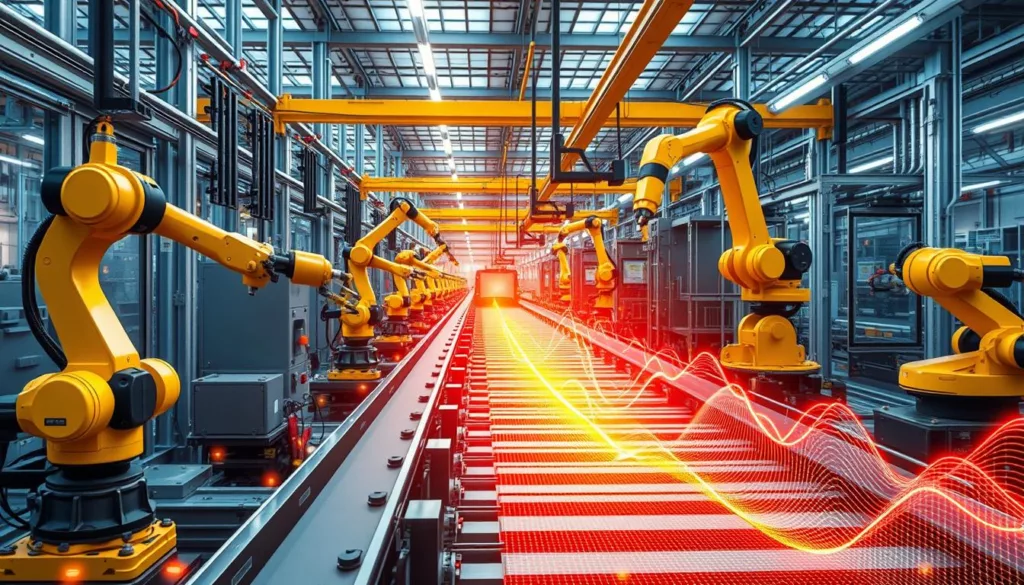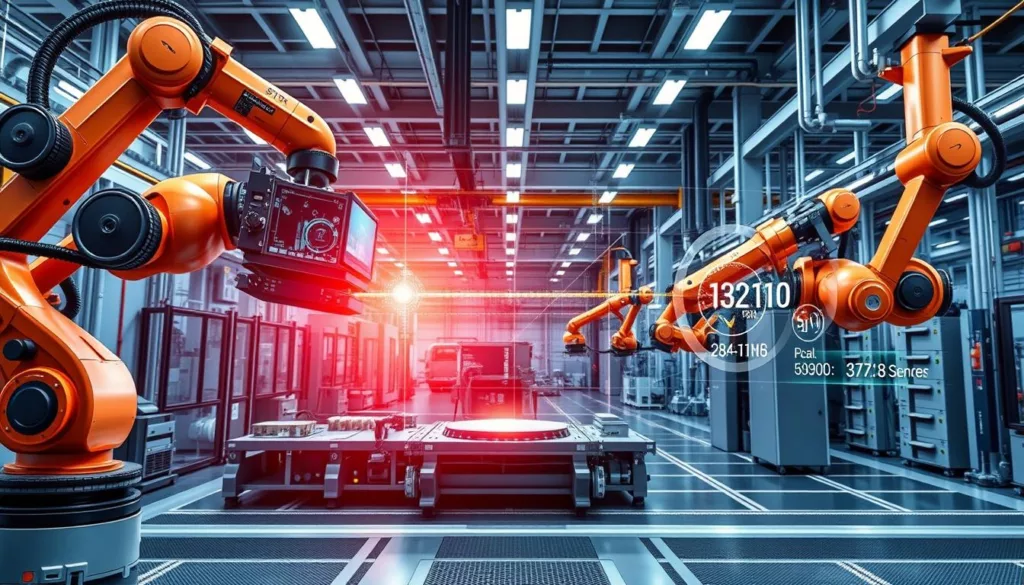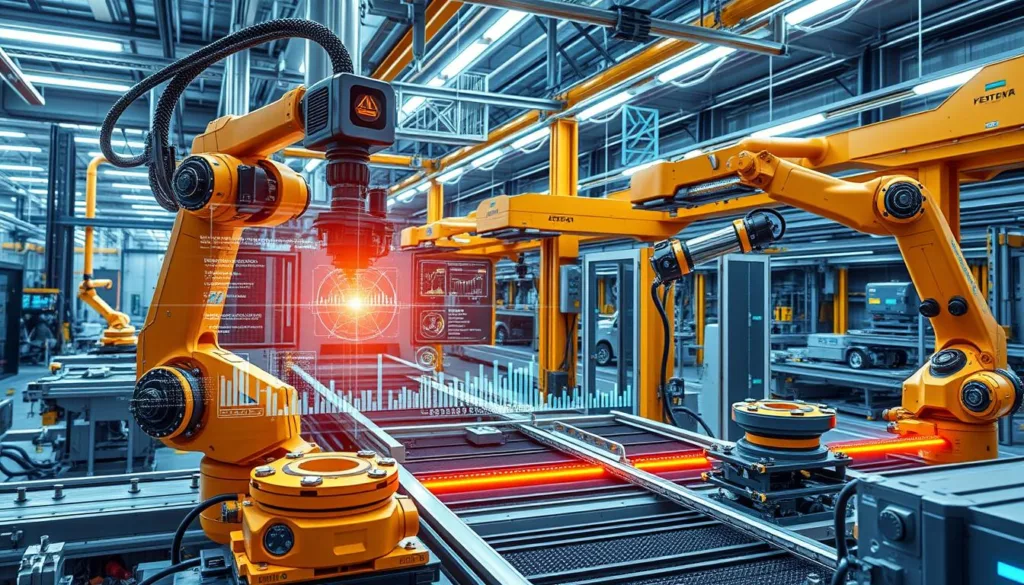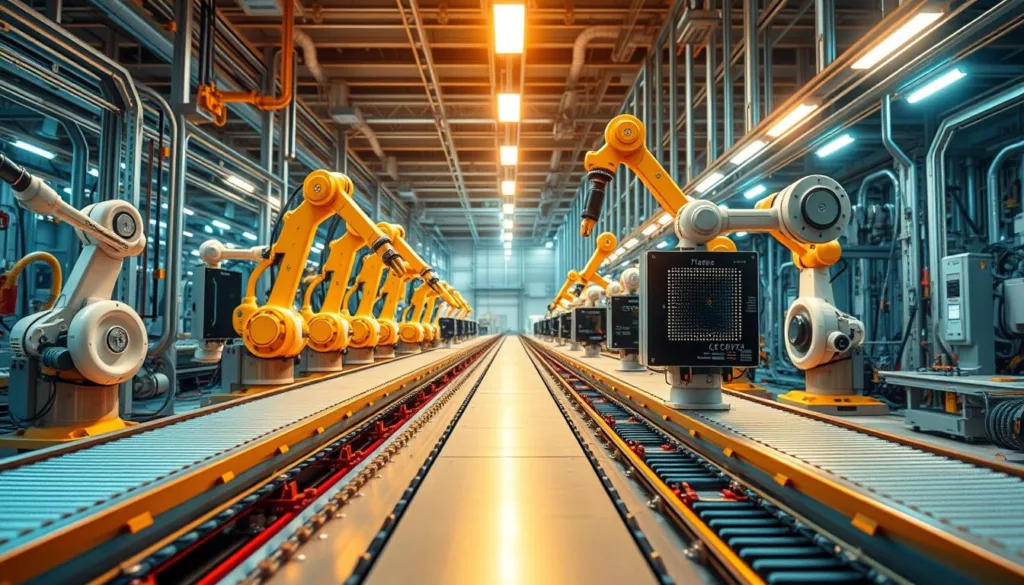In the world of automation, 3-axis sensors play a big role. They measure movement in three directions: X, Y, and Z. This helps us understand how things move and where they are, making things work better.
The data from these sensors gives us real-time information. This is key for industries that need to change fast. Let’s dive into how 3-axis sensors help in automation and how they’re key for Industry 4.0.
Key Takeaways
- 3-axis sensors measure motion across three dimensions, making data more accurate.
- Real-time data helps improve how things work in many areas.
- These sensors are essential for today’s automation systems.
- They support the growth of Industry 4.0 technologies.
- 3-axis sensors help control movement more precisely in factories.
Introduction to 3 Axis Sensors
3 axis sensor technology has changed automation a lot. These sensors help detect and control motion. They use both accelerometers and gyroscopes to work well.
They measure things like speed, direction, and how fast something turns. This makes machines work better and more efficiently. It’s a big deal for automation.
These sensors give precise data in many fields. They help businesses control their work better. This is a big advantage in automation.
Many industries, like manufacturing and robotics, use 3 axis sensors. As automation gets better, these sensors become even more important. They help make work smarter and more efficient.
For more info on force sensors in automated systems, check out this resource.
Benefits of using 3 axis sensors in automation
In the world of industrial automation, 3-axis sensors bring many benefits. They help improve how things work, making sure everything runs smoothly and efficiently. Here are two main advantages.
Enhanced Precision and Accuracy
3-axis sensors are known for their precision and accuracy. They measure movements and positions with great detail. This is important because small mistakes can cause big problems.
These sensors give feedback in real-time. This helps machines work better, leading to fewer mistakes in production. Using 3 axis sensors can make manufacturing safer and more productive.
Real-time Data Collection
One big plus of 3-axis sensors is their ability to collect data in real-time. This lets manufacturers keep an eye on how their equipment is doing. It helps them plan maintenance and make quick decisions.
Using this data for analysis can make operations more efficient. It also helps avoid unexpected stops. Overall, real-time data collection is key to managing and improving industrial automation.
Overview of Automation Technology
Automation technology is changing the way we work, making things more efficient and reducing the need for humans. It uses advanced automation sensors, controllers, and software. These parts work together to make manufacturing faster and more flexible.
Sensors are key in automation, giving detailed feedback on system states. For example, 3-axis sensors track position and movement. This helps control tasks better. Using automation technology like this, companies can improve how much they produce, the quality, and safety.
Companies using automation sensors see better efficiency and quick responses to production changes. This quickness gives them a competitive edge in today’s complex world. It helps them stay ahead in innovation and quality.
Key Components of Automation Sensors
In the world of automation, knowing the parts of automation sensors is key. These parts are vital for smooth operation in many automation systems.
Effective automation sensors have several important parts, focusing on 3 axis sensors. Each part helps the sensor work well and reliably.
- Sensors: These devices pick up things like temperature, pressure, and motion. They give important data for automation.
- Transducers: They turn sensor measurements into signals that other parts can understand.
- Controllers: Controllers get data from sensors, process it, and send commands for actions in the system.
- Data Interfaces: These help sensors and software talk to each other, improving data analysis.
Using 3-axis sensors makes these parts work better. This leads to more reliable automation in many fields.
Choosing top-notch automation sensors, like those with 3-axis technology, is essential. It boosts performance and keeps systems running smoothly.
Understanding Motion Control Sensors
Motion control sensors have changed many industries. They are key in making things work better, like in robotics and making things. Knowing how they work is important for those who want to make things more efficient.
Application in Robotics
In robotics, motion control sensors are very important. They help robots know where they are and how they’re moving. This lets robots move more accurately and work better.
Using these sensors makes robots more productive. It also makes them work better in factories.
Importance in Manufacturing
In factories, motion control sensors help things run smoothly. They help machines move in the right way. This makes making things faster and with fewer mistakes.
3 Axis Sensor Advantages in Industrial Automation Solutions
Using 3 axis sensors in industrial automation makes a big difference. They give precise data on motion. This helps increase productivity a lot.
Increased Efficiency
Adding 3 axis sensors boosts efficiency in industries. They track movement and position all the time. This helps manufacturers make their machines work better.
With these sensors, production gets faster. And the quality of what’s made stays high.
Reduced Downtime
Keeping equipment in good shape is key. The benefits of using 3 axis sensors in automation include watching over equipment health. They spot problems early.
This means maintenance can happen on time. And there’s less time when machines are down. This keeps production going strong.
Integrating 3 Axis Sensors into Automation Systems
Adding 3-axis sensors to automation systems needs a careful plan. We must check if they work well with what we already have. This ensures they talk to each other smoothly and work their best.
The type of communication is key. The right protocol lets sensors and systems share data. This makes everything work better together.
Being able to watch things in real-time is very important. With 3-axis sensors, we get data fast. This helps us make better choices.
Having one place to handle all the data is great. It lets us see how everything is doing together. This gives us a clear picture of how well our systems are working.
Having standard ways for sensors to talk to each other makes things easier. It makes adding new sensors to old systems simpler. This helps us make decisions based on solid data, making our automation work better.
Using 3-axis sensors brings many benefits. We see better automation, more work done, and fewer mistakes. By choosing the right way to integrate sensors, we make our automation technology work its best.
| Integration Aspect | Benefits |
|---|---|
| Compatibility Assessment | Ensures seamless functionality with existing systems |
| Communication Protocols | Facilitates effective data sharing |
| Real-time Monitoring | Enables timely data acquisition for improved decision-making |
| Standardized Interfaces | Promotes easier adaptation and integration process |
| Data Processing | Encourages a full view of system performance |
How 3 Axis Sensors Support Industry 4.0 Sensors
Industry 4.0 focuses on a networked manufacturing world with smart systems. In this world, 3-axis sensors are key. They turn old processes into smart factory uses. These sensors help by collecting and analyzing data better.
Smart Factory Applications
3-axis sensors make smart factories better by watching equipment and processes live. They help in many ways:
- Data-Driven Insights: They collect important data for making decisions and improving operations.
- Enhanced Communication: They work well with IoT devices, letting machines share data for a smooth factory.
- Adaptive Production: With data from 3-axis sensors, factories can quickly change to meet demand, improving schedules.
As automation grows, 3-axis sensors become more important for Industry 4.0. They help machines work together and collect accurate data. This leads to better productivity.
| Feature | Benefit |
|---|---|
| Real-Time Data Collection | Enables immediate response to equipment performance issues. |
| Interconnected Systems | Facilitates efficient communication between machines. |
| Performance Analytics | Helps in fine-tuning processes for enhanced output. |
| Flexibility in Production | Allows for quick adaptations to market demands. |
Sensor-Driven Automation Systems Explained
Understanding sensor-driven automation systems is key for modern industries. They use advanced technology for real-time data processing. This helps in making better decisions quickly.
The use of AI with 3-axis sensors is leading this change. It brings big improvements to automation.
Connecting Sensors with AI
Sensors and AI work together to make automation smarter. AI helps these systems analyze big data from sensors. This leads to better insights and smarter solutions.
Some main benefits of using AI with sensor-driven automation include:
- Real-Time Analysis: Data is processed right away, allowing for quick changes.
- Predictive Maintenance: It predicts when equipment might fail, cutting down on downtime.
- Increased Agility: Systems can adjust to new situations, improving performance and using resources better.
The partnership between sensor-driven automation and AI makes processes smoother. It also saves costs in many industries.
| Feature | Benefits |
|---|---|
| Real-Time Analysis | Enables quick adjustments to operations, improving overall performance. |
| Predictive Maintenance | Reduces costs by minimizing unplanned downtime and extending asset life. |
| Increased Agility | Improves resource management and responsiveness to market changes. |
Future Trends in Automation Technology Benefits
The world of automation is changing fast. New sensor technologies are leading the way to better solutions. These advancements make work more efficient and change what skills are needed in the job market. It’s key for professionals to keep up with these trends.
Advancements in Sensor Technology
New sensor tech will aim to be more accurate, smaller, and connected. Wireless and nanotechnology sensors are set to change how automation works. They will offer better and more flexible solutions for different industries.
Impact on Workforce Skills
As automation gets better, the skills needed for jobs will change a lot. People will need to learn new things and keep learning. Knowing about sensors and data analysis will be very important. This shows how important it is to keep learning in an automated world.
XJCSENSOR: Pioneering 3 Axis Sensor Technology
XJCSENSOR is at the forefront of 3 axis sensor technology. We offer top-notch sensor solutions for many industries. Our deep knowledge in sensor engineering helps us serve sectors like automotive, healthcare, and manufacturing.
We focus on making our products perform well and adapt quickly. This ensures they meet the changing needs of today’s automation systems. Our commitment to precision boosts efficiency in various applications.
- Versatile Applications: Suitable for a wide range of industries, adapting to specific use cases.
- Improved Data Accuracy: Captures precise measurements in real-time, bolstering decision-making processes.
- Reliability: Designed for long-term durability, fostering trust in sensor outputs.
XJCSENSOR not only pushes technology forward but also works closely with clients. We create custom solutions that help advance automation systems.
| Feature | Description |
|---|---|
| Precision | Ensures accurate readings across all three axes. |
| Adaptability | Meets the demands of various industries and applications. |
| Durability | Built to withstand harsh industrial environments. |
Our commitment to innovation and quality makes XJCSENSOR a reliable partner in advanced automation technology.
Challenges in Implementing 3 Axis Sensors
Adding 3-axis sensors to automation systems comes with its own set of hurdles. These obstacles can affect how well the technology works. It’s key to grasp these complexities to find the right ways to overcome them.
Cost Considerations
Starting with 3-axis sensors can be pricey. Costs include buying, setting up, and linking these sensors. Companies must weigh the benefits against the costs carefully. This means looking at the initial price and ongoing expenses.
For those looking for unique solutions, XJCSENSOR offers creative ways to handle these costs.
Technical Expertise Required
Another big challenge is finding people skilled in using these sensors. They need to understand complex data and solve problems. This might mean training staff or working with outside experts.
Training programs are vital. They help teams learn how to use 3-axis sensors effectively.
| Challenge | Description | Potential Solution |
|---|---|---|
| Cost Considerations | High initial investments including procurement and integration | Conduct a detailed cost-benefit analysis |
| Technical Expertise Required | Need for specialized personnel for data handling and system integration | Invest in training or collaborate with specialists |
Conclusion
Using 3-axis sensors in automation technology offers big advantages. These include better precision, efficiency, and real-time data. As industries move towards smarter solutions, these sensors are key to innovation and excellence.
By adding 3-axis sensors to their operations, businesses can make things run smoother. This leads to better performance and a strong competitive edge.
Working with leaders like XJCSENSOR helps companies deal with sensor integration challenges. They focus on providing top-notch, custom solutions. This lets users get the most out of 3-axis technology.
Investing in skilled suppliers like XJCSENSOR boosts the benefits of 3-axis sensors. This is true for companies aiming to succeed in an automated world.
In short, using 3-axis sensors smartly opens up many chances for businesses to grow. As industries keep changing, those who focus on the latest tech and reliable partners will do well. This includes XJCSENSOR.





